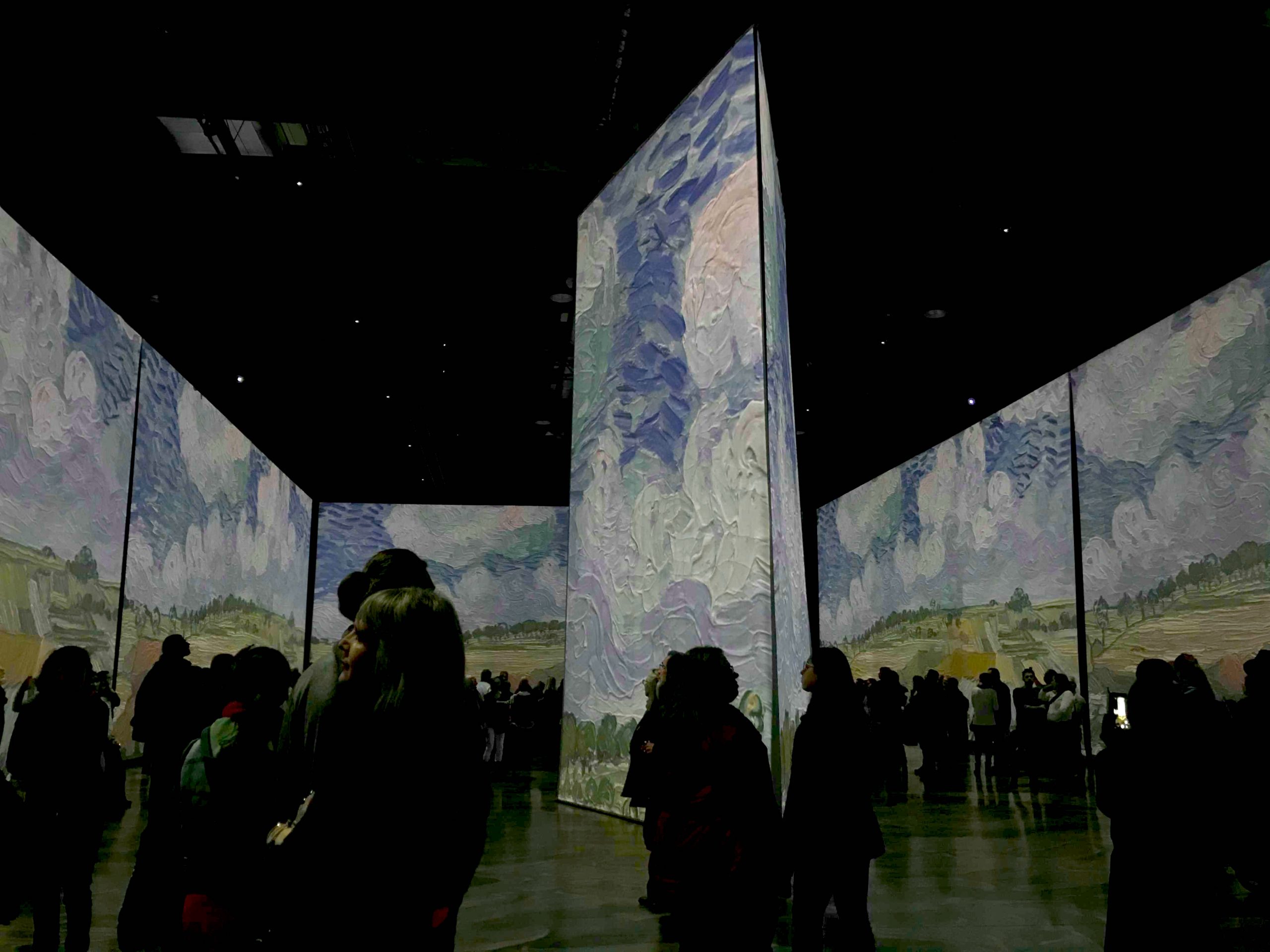Read our take on the exhibition on everyone’s newsfeed
THE GOOD
Youmna El Halabi, Opinions Editor
It comes as no surprise to anyone who knows me that Van Gogh is one of my favourite painters ever. Imagine Van Gogh can be described as a visual presentation of all of the artist’s life’s work on several screens filling the gallery — even the floor.
The room goes dark, and suddenly a pair of familiar eyes stare right into my soul. As the image zooms out, the artist’s self portrait comes into view, and my eyes instantly teared up. Such pain, such agony, such melancholy, and such passion. Van Gogh disappears, his sketches make an appearance, and begin paving the way to what eventually made him famous.
The exhibition was all-consuming, all-too-captivating, and at times, even overwhelming. Normally I would walk around in a gallery, my own music in my ears, trying to depict whatever the artist attempted to convey. Imagine Van Gogh, I felt, was not like a normal exposition. I didn’t walk around, nor did I feel the need to. I remember feeling the urge to find a corner in the room, sit there comfortably, and watch.
As Van Gogh’s work unfolds right in front of me, I am engulfed in all the colours of his palette. From the blinding yellow of his decaying but bright Sunflowers, to the depth of the indigo blue in Starry Night.
There are very few things in this world that would make me cry in public, and Imagine Van Gogh definitely made the list. Imagine Van Gogh brought me into a world I never wanted to leave — if I were without responsibilities and bills, I wouldn’t have.
THE BAD
Lisa Massa, Contributor
I love a good blockbuster exhibition every now and then. Between the many advertisements plastered on social media and the many queries from friends and family, I knew Imagine Van Gogh had to make its way on my checklist.
Before getting into the actual exhibition, there is a room dedicated to contextualizing the life of Van Gogh. Chronologically organized, suspended placards provided visitors with a significant amount of information of the artist’s journey, from his youth until his death in 1890, at 37.
For those interested in art and art history but sometimes feel intimidated by being within a traditional museum atmosphere, Imagine Van Gogh offered a new perspective on engaging with art. The space is dynamic with people of all ages, freely conversing and laughing while looking at the projections of Van Gogh’s stunning paintings.
I view Imagine Van Gogh much the same as I do many major art exhibitions – a great way to immerse the general population into the art world, drawing interest from various age groups and backgrounds.
The exhibition was pretty lackluster overall to say the least. In total, I spent approximately 45 minutes in the space, unsure of whether I had seen a full loop or not, and not caring to stay any longer. After a while, the exhibition was boring. The way I see it goes as follows: when one enters a museum for a solo visit, the guest has full autonomy in choosing what they wish to see, and in what order (most times, anyway).
Imagine Van Gogh only had one room of projections, which felt incomplete. Once in the space, the novelty of being immersed in the paintings wears off, leaving me wondering what made this different than a blown up PowerPoint presentation. Van Gogh’s works were originally quite small, averaging approximately 30cm x 40cm so, by increasing the scale of his works to be greater than human, I did not exactly feel immersed into the paintings. Rather, I felt surrounded or trapped by them.
THE UGLY
Lorenza Mezzapelle, Assistant Arts Editor
My initial reaction to the advertisements for Imagine Van Gogh in Montreal was along the lines of “Oh wow, that’s where all those Instagram photos come from.” I had seen many Scandinavian and European influencers posting photos of the large projections, but never bothered researching the source. I simply assumed the photos were from the Van Gogh Museum in Amsterdam.
The idea of a renowned artist’s work being this heavily marketed intrigued me for numerous reasons. I wondered, why Van Gogh? I came to the conclusion that everyone knows Van Gogh, and thus, displaying his work meant accessibility. But therein lies the dilemma. With tickets prices varying by age, day and time of attendance, the show is in no way accessible. While Van Gogh is known by even non-connoisseurs, the exhibition does not lend itself to the democratization of art. While a fantastic idea in theory, Imagine Van Gogh remains fundamentally problematic.
I would be lying if I said I wasn’t mesmerized by the colours that seemed to dance alongside some of my favourite classical music. Seeing the enlarged brushstrokes of the artist’s famous self-portraits was definitely a remarkable experience.
However, as marketed, and much along the lines of my initial association to Instagram influencers, the exhibition remained a marketing trap. The majority of visitors skipped past the biographical information and curator’s statement, immediately taking out their phones to document the experience. The amount of phone screens lit up in the room made it feel less like an artistic experience, and more like an elitist, social media trap disguised as culture.
While I wish I could say that Imagine Van Gogh will continue to enable the general public — both those well-versed in art, and those not — to experience and understand the history of a great artist, I cannot.
There is no doubt the experience was beautiful, but it remains too inaccessible to be appreciated by most.
Photo by Lorenza Mezzapelle.
